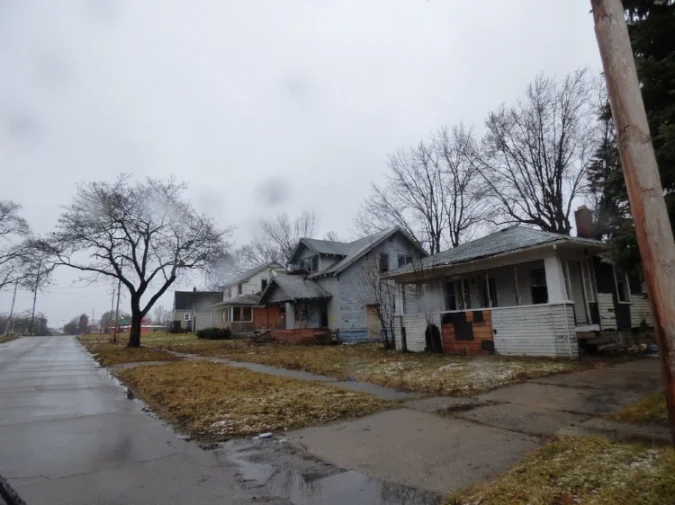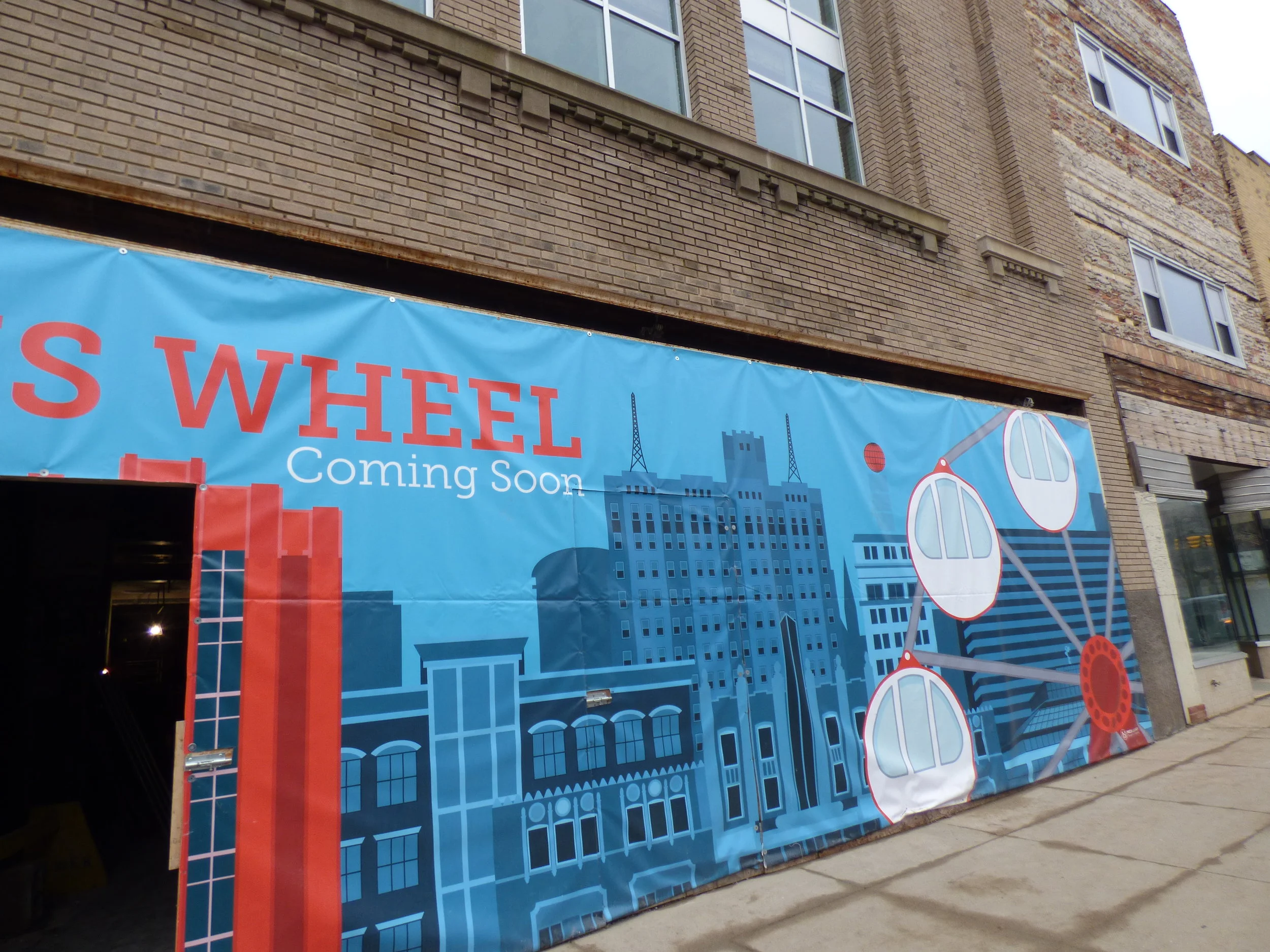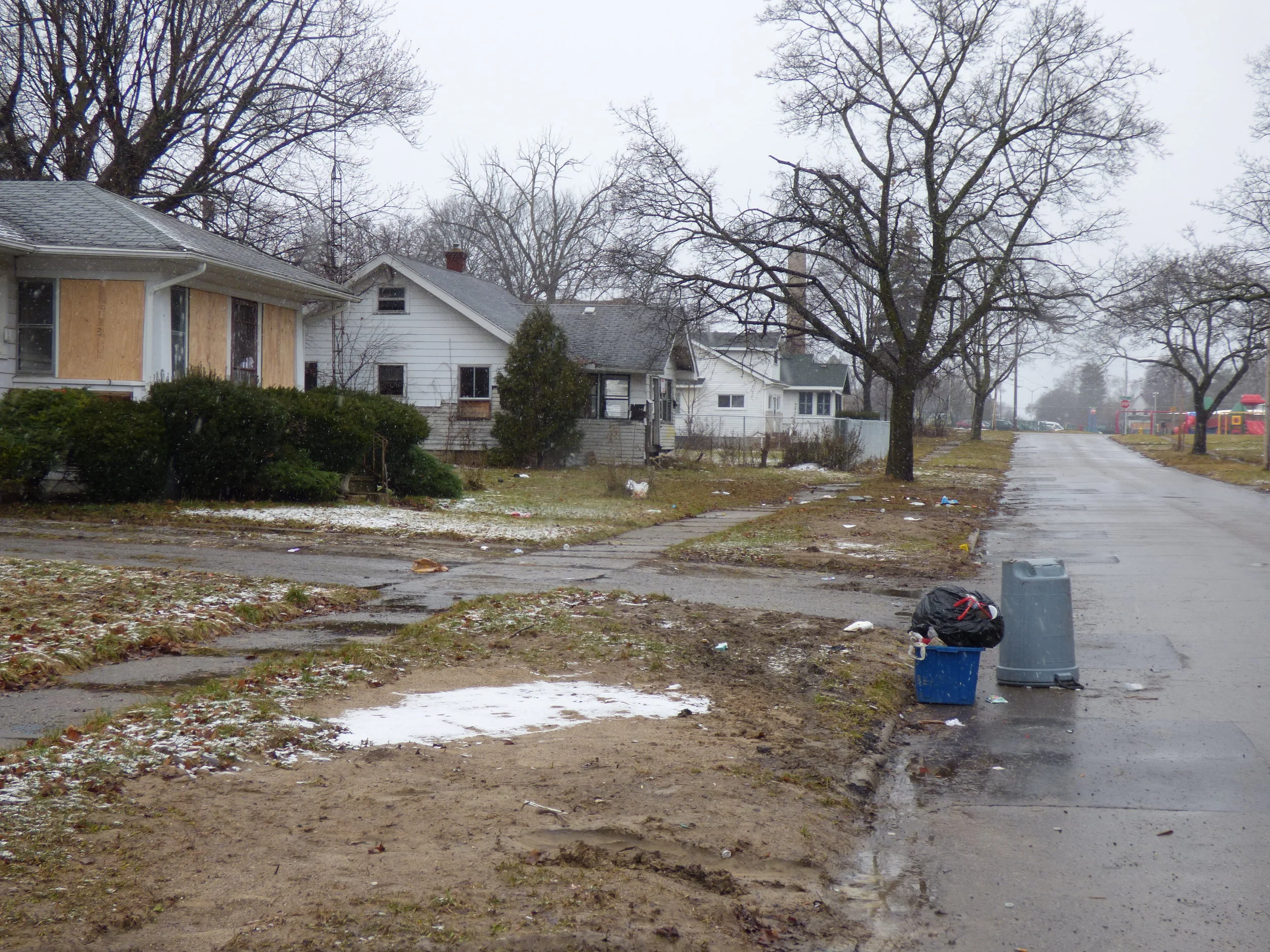Our trip to Flint was extra special to me, because it’s where I am originally from. My family moved to Northern New York when I was five, but I still have many memories about life there. And although it wasn’t perfect, Flint seemed pretty great to me. This trip allowed me to visit and recall many of those great memories, but it also sparked new emotions because much of Flint didn’t resemble what I remembered leaving in 1989.
Jennifer Acree from the Mott Foundation was gracious enough to take us on a tour of the City and show us some new exciting projects, beautiful neighborhoods, major cultural institutions, and successful revitalization projects. However, we were also able to see some of the neighborhoods that have been most affected by job loss, economic disinvestment, and infrastructure failure. One of those neighborhoods was mine.
My memories started to trigger as we drove around Mott Park. Many of my happiest hours were spent going for rides through this neighborhood on the back of my dad’s bicycle. The park still seemed to be in good shape, but Jennifer explained that community has really had to band together to keep it that way. Neighbors and even college fraternities volunteer their time maintaining the park by mowing and picking up litter and debris. Earlier in the week, people with the Metro Community Development Center told us that they are targeting the Mott Park neighborhood as a potential transitional neighborhood and trying to increase homeownership there. They think that the neighborhood is at a tipping point and could either become revitalized or blighted.
As we drove north away from the park, we started to approach my old Street, Wolcott. Before we reached my block, the neighborhood was already starting to feel different than many of the other neighborhoods that we had already visited. We passed what would have been my school, and where I spent many days playing on the playground. The school was closed, and surrounded by a chain link fence. People had spelled out different messages in the fence, by placing empty water bottles in its openings to form letters. Many messages read things like “Rest in Peace.”
As we neared my block, I started to worry. Yes, we had already seen blight in other Flint neighborhoods, however, I wasn’t fully prepared for seeing this on my old block, where there were over a dozen vacant houses and empty lots. My house was still there, and lived in, but the neighborhood had a completely different feeling than what I remembered. Seeing this filled me with a mix of thoughts and emotions. How would my life have turned out if we stayed here? What are the resident’s lives like now? Will my street ever be active and lively again?
-Adria Finch
Wolcott St., Flint, MI
We drove further out towards the Northside of Flint, passing completely demolished blocks that were more akin to fields and parks than to city blocks where homes once stood. Other blocks had scattered houses left standing, mostly in states of disrepair. We eventually landed on “Buick City,” a drab, two-mile long stretch of fenced-in land; the only thing left of the manufacturing boom that once existed in the city were cement slabs and stacks of large pipes.
Buick City, Flint, MI.
Image source: Michigan Radio
Flint’s economic history is not unique. A once booming, middle-class city riding on the waves of Chevy and Buick car production was left writhing at the loss of manufacturing, much like every other “rust-belt” city in the Northeastern United States, Syracuse included. As many of Adria’s family had to, when the jobs left, people left with them. Those left behind were residents with little resources, skills or education to pick themselves up and start over in a new place.
The water crisis only exacerbated these conditions. Residents of the city who could afford to move away often did. Flint’s population just recently dropped below 100,000. Low-income families are the most likely to have continued lead exposure, impacting their children’s educational outcomes. School choice policies in Genesee County allow children to attend any of multiple school districts in the area as long as families can provide their own transportation. This leaves the families and students with the highest levels of need in the most under-resourced school district in the City of Flint.
Jennifer brought us past closed and vacant school buildings and parks known to be hubs for criminal activity, but all with stories of progress and hope. Even in the neighborhoods with the highest vacancy rates, there were still homes tucked away that had proud, vested owners and residents. It was very powerful to see that even in some of the hardest hit communities, there were still residents full of pride and commitment to make Flint a desireable community. Where we find tragedy, we also find the most inspiring stories of human resilience.
The water crisis did have a silver lining in that it refocused and brought together community resources. Flint now has the Flint Future Action Coordination Team, a group of representatives from all of the major sectors in the city, including philanthropy, non-profit services, private business, the City and the State. This team coordinates different project and funding efforts, and keeps everyone aware of arising and persisting issues in the community and how different groups are addressing them. Many funding priorities have been coordinated through this group to address the water needs of the city under four categories: Health and Safety, Education, Capacity Building, and Economic Recovery.
Not directly related to the water crisis, other institutions and organizations are working to tackle neighborhood health, education and community development. The University of Michigan Flint has recently received a Byrne Criminal Justice Grant to map areas of high criminal activity in the city. Armed with this information, Kettering University - an institution that has taken a role in keeping the communities and neighborhoods directly bordering its campus healthy, including Chevy Commons - was able to attract a Jimmy Johns to locate where an old corner store with high crime rates used to be. The crime hotspot for that block is now gone.
The University of Michigan Flint GIS Center is also participating in a community-wide project called Map Flint. This project creates public maps and data sets for use by organizations and residents alike. It’s advisory board includes the City, area school districts, major philanthropic funders, and other economic development organizations.
Another successful community project has been the Flint Community Schools initiative. Widely supported by the C.S. Mott Foundation and the Crim Fitness Foundation, the initiative partners to provide kids and families with a comprehensive set of programs and supports. It expanded to all 11 schools in the Flint City School District for the 2016-17 school year. Crim thus far has successfully made partnerships with organizations and nonprofits to turn city schools into full-day, year-round centers for their surrounding communities. A future goal is to move to a two-generation model to be able to provide workforce training for the parents of children attending the schools.
Many community organizations in Flint are focused on job training. Flint’s Chamber of Commerce and Metro Community Development have created robust programs to get Flint residents ready for work, especially focusing on the youth in the community. The Chamber’s YouthQuest program teaches soft skills and resume building and then places youth in summer jobs with nonprofits and local businesses, subsidizing the student’s wages for participating employers. Metro Community Development’s Youthbuild program emphasizes “mental toughness” and works with local unions to connect youth to job training and apprenticeships in different trades.
We learned about so many amazing programs in Flint - like coordination around access to healthy food, the literacy network, housing and business development in their downtown, the Building Neighborhood Capacity program, a new co-works space in the Ferris Building, and the Flint Sprint - that we don’t have room to talk about here. We want to give our warmest thanks to the City of Flint, the C.S. Mott Foundation, the Metro Community Development Center, the Center for Community Progress, the Flint Area Reinvestment Office, the Flint Chamber of Commerce, and the University of Michigan, Flint GIS Center for hosting us and helping us learn about the important work that you’re all doing.










